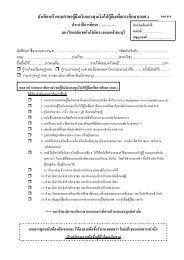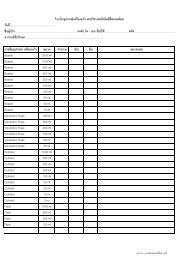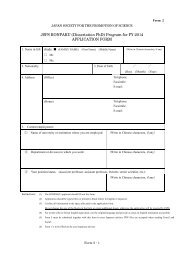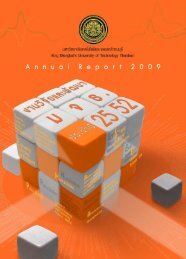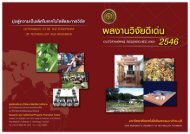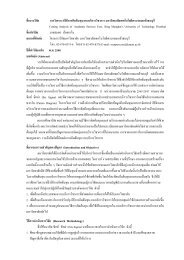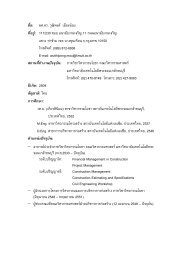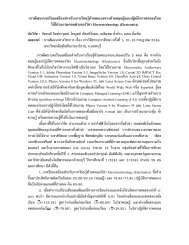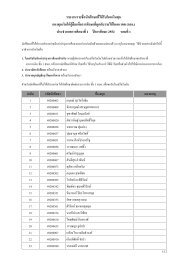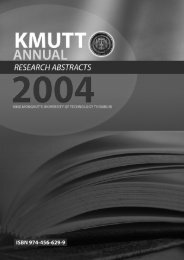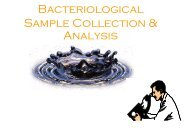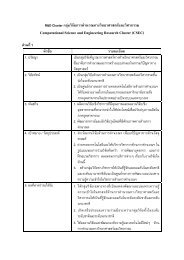Create successful ePaper yourself
Turn your PDF publications into a flip-book with our unique Google optimized e-Paper software.
KMUTT Annual Research Abstracts 2005<br />
be inspected and repaired along their life time.<br />
In addition the concentration of sulfur<br />
compound increases due to the accumulation of<br />
the deposit inside the tank, and so does the<br />
corrosive rate. In this paper, Acoustic Emission<br />
(AE) has been chosen to study the characteristic<br />
of AE signals received from the uniform<br />
corrosion mechanism of mild steel (A36) in<br />
various concentrations of Sulfuric acid (H2SO4)<br />
solution. AE signals were captured using a<br />
resonant sensor and recorded by AE system<br />
model LOCAN 320 and spectrum analyzer (HP-<br />
4001A). The relationship between AE signals<br />
and sulfur concentrations were exhibited.<br />
Furthermore the phenomenon of passivation<br />
stage on material was explained via AE<br />
parameter analysis.<br />
IC-097 EFFECT OF SULFURIC ACID<br />
CONCENTRATION ON ACOUSTIC EMISSION<br />
SIGNALS OBTAINED FORM UNIFORM-<br />
CORROSION<br />
Asa Prateepasen, Chalermkiat Jirarungsatean,<br />
Pongsak Tuengsuk<br />
The 1 st International Conference on Advanced<br />
Nondestructive Evaluation (ANDE 2005),<br />
November 7-9, 2005, ICC, Jeju, Korea<br />
In Petroleum industry, corrosion failures<br />
of steel structures are common. The severity of<br />
corrosion in oil distilleries inorganic compounds<br />
is higher than in those of organic compounds.<br />
Inorganic compounds such as sulfur are the most<br />
influential corrosive activators inside oil or<br />
chemical storage tanks. They make the tanks to<br />
be inspected and repaired along their life time.<br />
In addition the concentration of sulfur<br />
compound increases due to the accumulation of<br />
the deposit inside the tank, and so does the<br />
corrosive rate. In this paper, Acoustic Emission<br />
(AE) has been chosen to study the characteristic<br />
of AE signals received from the uniform<br />
corrosion mechanism of mild steel (A36) in<br />
various concentrations of Sulfuric acid (H2SO4)<br />
solution. AE signals were captured using a<br />
resonant sensor and recorded by AE system<br />
model LOCAN 320 and spectrum analyzer (HP-<br />
4001A). The relationship between AE signals<br />
and sulfur concentrations were exhibited.<br />
Furthermore the phenomenon of passivation<br />
stage on material was explained via AE<br />
parameter analysis.<br />
IC-098 IDENTIFICATION OF AE SOURCE IN<br />
CORROSION PROCESS<br />
Asa Prateepasen, Chalermkiat Jirarungsatean,<br />
Pongsak Tuengsuk<br />
The 1 st International Conference on Advanced<br />
Nondestructive Evaluation (ANDE 2005),<br />
November 7-9, 2005, ICC, Jeju, Korea<br />
109<br />
In this paper acoustic emission (AE), a<br />
nondestructive testing technique, was<br />
implemented to detect and study the corrosion<br />
on austenitic stainless steel grade AISI 304. A<br />
number of previous researches on application of<br />
Acoustic Emission (AE) in evaluation of<br />
corrosion in steel were reviewed. Two tests were<br />
conducted at room temperature using an acidic<br />
30% Chloride solution in passive tests procedure<br />
and 3% NaCl solution in electrochemical<br />
process. From the experimental works, it<br />
appears that AE signals can be detected during<br />
corrosion. Data are studied in time and<br />
frequency domain to characterize and to find out<br />
the relation between AE parameter and<br />
corrosion. In addition the source of generated<br />
acoustic signals and corrosive mechanism in the<br />
different corrosive environment condition were<br />
discussed.<br />
IC-099 A STUDY ON SOURCE LOCATION<br />
USING ACOUSTIC EMISSION SYSTEM ON<br />
VARIOUS TYPES OF CORROSION IN<br />
INDUSTRY<br />
Asa Prateepasen, Cherdpong Jomdecha,<br />
Pakorn Kaewtrakulpong<br />
The 3 rd US-Japan Symposium on Advancing<br />
Applications and Capabilities in NDE, June 20-<br />
24, 2005, Maui Prince Hotel, Maui, Hawaii,<br />
USA., pp. 42-43<br />
Corrosion is one of the main causes of<br />
catastrophes in many industries especially<br />
petrochemicals. Several conventional NDT<br />
techniques such as MT PT and UT have been<br />
applied to locate and determine its severity.<br />
However, these techniques require process<br />
disruption and a great deal of preparation for<br />
example; drainage of material from inspection<br />
specimens. Acoustic Emission (AE) inspection<br />
has been introduced to the problem and gain<br />
popularity mainly due to its online<br />
characteristic. This allows contiguous<br />
monitoring of the inspection area without any<br />
process interruption.<br />
A number of researches have been done<br />
in the area of detecting and classifying severity<br />
levels of corrosion detected by AE inspection.<br />
International Conference



